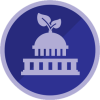Introducing eeGuidance for Reopening Schools

NAAEE is excited to share eeGuidance for Reopening Schools, a new publication that offers support for schools and districts as they find ways to more safely and equitably reopen for students this fall. Developed in collaboration with leaders in the NAAEE Affiliate Network, the guidance offers dozens of specific recommendations for schools and districts, including using the school grounds for outdoor classroom spaces as a strategy for adhering to physical distancing guidelines; engaging community environmental and outdoor education programs, such as nature centers, as alternative spaces for learning; tapping into the expertise of environmental educators to support teaching and learning; creating healthier learning environments; and supporting at-home learning. NAAEE Affiliates are customizing the overall guidance and individual recommendations to address the specific timelines and circumstances influencing plans for reopening in their states and provinces.
Schools everywhere are facing daunting challenges and costs associated with plans to reopen for the 2020-21 school year. eeGuidance offers some creative ideas for using outdoor spaces and leveraging partnerships with environmental educators to address some of those challenges. Integrating outdoor and environmental education into both school and home-based plans for learning can help schools continue in their efforts to provide a rich and well-rounded education for all students that supports not only their academic, but also their health and social-emotional needs during these difficult times. The American Academy of Pediatrics (AAP) has issued new guidelines for reopening schools that emphasize the importance of getting children of all ages back to school for a wide range of reasons, including supporting achievement, stress reduction, food security, and more. Among the recommendations provided by the AAP—use outdoor spaces as much as possible to reduce risk and accommodate social distancing.
A recent survey conducted by the Lawrence Hall of Science at Berkeley University documents the losses in program hours and participant revenue for the environmental education program providers, and the significant risks of permanent program closures. Of particular concern, the survey found that “in the likely event that the COVID-19 pandemic restrictions continue nationwide through the end of 2020, an alarming 63% of program leaders feel uncertain about their ability to reopen their doors.” This would be an enormous loss of talent, as well as learning opportunities for students everywhere. Finding opportunities to partner with schools and school districts in providing educational programming, physical spaces for learning, teacher professional development, and more may provide a win-win for nonformal programs and schools alike in navigating the impacts of the pandemic on normal operations.
While the recommendations in the eeGuidance are designed to help schools address some near term and pragmatic needs associated with capacity and engaging content, there’s great potential for long-term benefits. Stronger partnerships between EE program providers and school districts may lead to greater systemic integration of EE across the curriculum and more equitable access to these enriching and engaging programs. Incorporating regular opportunities to engage in outdoor environmental education as part of the curriculum—whether on the school grounds or at home—will ultimately contribute to the academic success, physical and mental health, and overall wellbeing of students. And that’s something we can all get behind.
Download eeGuidance for Reopening Schools
Document






